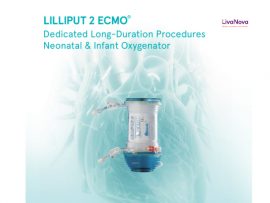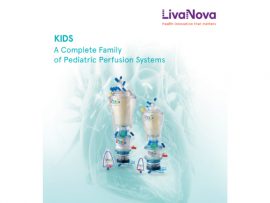Abstract Introduction Veno-venous extracorporeal membrane oxygenation has increasingly been utilized to support patients in respiratory failure as a bridge to recovery or lung transplantation. As patients progress from cannulation to..
Read MoreAbstract Pediatric extracorporeal membrane oxygenation (ECMO) provides lifesaving cardiopulmonary support for patients with a multitude of clinical diagnoses, resulting from cardiac and/or respiratory failure refractory to conventional supports (). The..
Read MoreAbstract BACKGROUND Patients with severe traumatic brain injury (TBI) are at an increased risk of respiratory failure refractory to traditional therapies. The safety of extracorporeal membrane oxygenation (ECMO) in this..
Read MoreAbstract Background: Individuals undergoing cardiac surgery face an increased risk of bleeding, as well as alterations in biochemical and coagulation patterns. Therefore, assessing the effectiveness of systems such as Cell..
Read MoreAbstract Direct oral anticoagulants (DOACs) are increasingly being used due to their improved efficacy/safety ratio and lower clinical and economic burden when compared to vitamin K antagonists. However, bleeding is..
Read MoreAbstract Background Cerebral microbleeds (CMBs) are common and varied in patients receiving extracorporeal membrane oxygenation (ECMO). Here, the authors describe CMB findings in patients receiving ECMO and their association with..
Read MoreAbstract Protamine sulfate is a standard agent used to reverse heparin anticoagulation during cardiovascular procedures such as coronary artery bypass grafting (CABG). Although rare, it can be associated with severe..
Read MoreAbstract Objective Extracorporeal membrane oxygenation (ECMO) requires systemic anticoagulation to reduce the risk of thromboembolic events. Despite its historic role, activated clotting time (ACT) remains a widely used heparin monitoring..
Read MoreAbstract The safe use of cardiopulmonary bypass (CPB) relies upon the ability to administer, monitor, and reverse anticoagulation. Although rare, the factor XII deficient patient creates a challenge for the..
Read MoreAbstract Extracorporeal membrane oxygenation (ECMO) is a mechanical support treatment modality used in patients with refractory cardiac and/or pulmonary failure. Bleeding and thrombotic complications associated with ECMO are inherent concerns..
Read MoreAbstract Background Drug shortages are a frequent challenge in current clinical practice. Certain drugs (e.g., protamine) lack alternatives, and inadequate supplies can limit access to services. Conventional protamine dosing uses..
Read MoreAbstract OBJECTIVES: Continuous, therapeutic anticoagulation is the standard of care for patients on extracorporeal membrane oxygenation (ECMO). The risks of hemorrhage exacerbated by anticoagulation must be weighed with the thrombotic..
Read MoreAbstract Despite abundant clinical innovation and burgeoning scientific investigation, pulmonary embolism (PE) has continued to pose a diagnostic and management challenge worldwide. Aging populations, patients living with a mounting number..
Read MoreAbstract OBJECTIVES: To identify and prioritize research questions for anticoagulation and hemostasis management of neonates and children supported with extracorporeal membrane oxygenation (ECMO) from the Pediatric ECMO Anticoagulation CollaborativE (PEACE)..
Read MoreAbstract OBJECTIVES: To derive systematic-review informed, modified Delphi consensus regarding the medications used for anticoagulation for pediatric extracorporeal membrane oxygenation (ECMO) for the Pediatric ECMO Anticoagulation CollaborativE (PEACE). DATA SOURCES: ..
Read MoreAbstract This study investigates the prevalence and risk factors associated with venous thrombotic events in patients receiving (ECMO) support. Systematic review and meta-analysis of case-control and cohort studies. PubMed, Cochrane..
Read MoreAbstract Background: Patients maintained on extracorporeal membrane oxygenation (ECMO) often require systemic anticoagulation to prevent circuit clotting and systemic thromboembolic complications. The optimal intensity of anticoagulation to balance the risk..
Read MoreAbstract Cardiopulmonary bypass (CPB) and veno-arterial extracorporeal membrane oxygenation are critical tools in contemporary cardiac surgery and intensive care, respectively. While these techniques share similar components, their application contexts differ,..
Read MoreAbstract Background and Objectives Neonatal cardiac surgery requires careful consideration of cardiopulmonary bypass (CPB) priming fluid composition due to small blood volume and immature physiology. This study investigated the impact..
Read MoreAbstract Pediatric extracorporeal membrane oxygenation (ECMO) provides lifesaving cardiopulmonary support for patients with a multitude of clinical diagnoses, resulting from cardiac and/or respiratory failure refractory to conventional supports. The utilization..
Read MoreAbstract Human fibrinogen (FIB) has been clinically proven to be considerably effective for the treatment of postoperative bleeding, with reported cases of allergic reactions to human FIB being rare. Here,..
Read MoreAbstract OBJECTIVES Extracorporeal circulation induces pronounced effects on haemostasis and rheology. To study these, an ex vivo simulation model is an attractive alternative but often requires large amounts of blood. We sought..
Read MoreAbstract Thrombosis and plasma leakage are two of the most frequent dysfunctions of polypropylene (PP) hollow fiber membrane (PPM) used in extracorporeal membrane oxygenation (ECMO) therapy. In this study, a..
Read MoreAbstract Introduction: Acute pulmonary embolism (PE) leads to increased pulmonary vascular resistance and right ventricular afterload, resulting in right ventricular dysfunction (RVD). Stratification is crucial to early identify patients with elevated..
Read MoreAbstract Introduction: Amniotic fluid embolism (AFE) is a catastrophic complication of pregnancy with high mortality rate. It is an inflammatory response leading to cardiovascular collapse. We present a case of successful..
Read MoreAbstract Cardiac surgery is a distinctive surgical discipline that often necessitates the use of cardiopulmonary bypass (CPB) and full anticoagulation intraoperatively, along with varying levels of antithrombotic treatments both before..
Read MoreAbstract Background Coagulatory alterations are common after pediatric cardiac surgery and can be addressed with point-of-care (POC) coagulation analysis. The aim of the present study is to evaluate a preventive..
Read MoreAbstract Objective Systemic heparinization during cardiopulmonary bypass (CPB) can significantly affect thromboelastography (TEG). This study investigated the feasibility of adding protamine in vitro to allow assessment of coagulation status using the..
Read MoreAbstract Background Evidence supporting with unfractionated heparin (UFH) in patients with an intra-aortic balloon pump (IABP) to prevent remains limited, while bleeding risks remain high. Monitoring heparin in this setting with anti-factor..
Read MoreAbstract Cardiopulmonary bypass (CPB) and veno-arterial extracorporeal membrane oxygenation are critical tools in contemporary cardiac surgery and intensive care, respectively. While these techniques share similar components, their application contexts differ,..
Read More

















